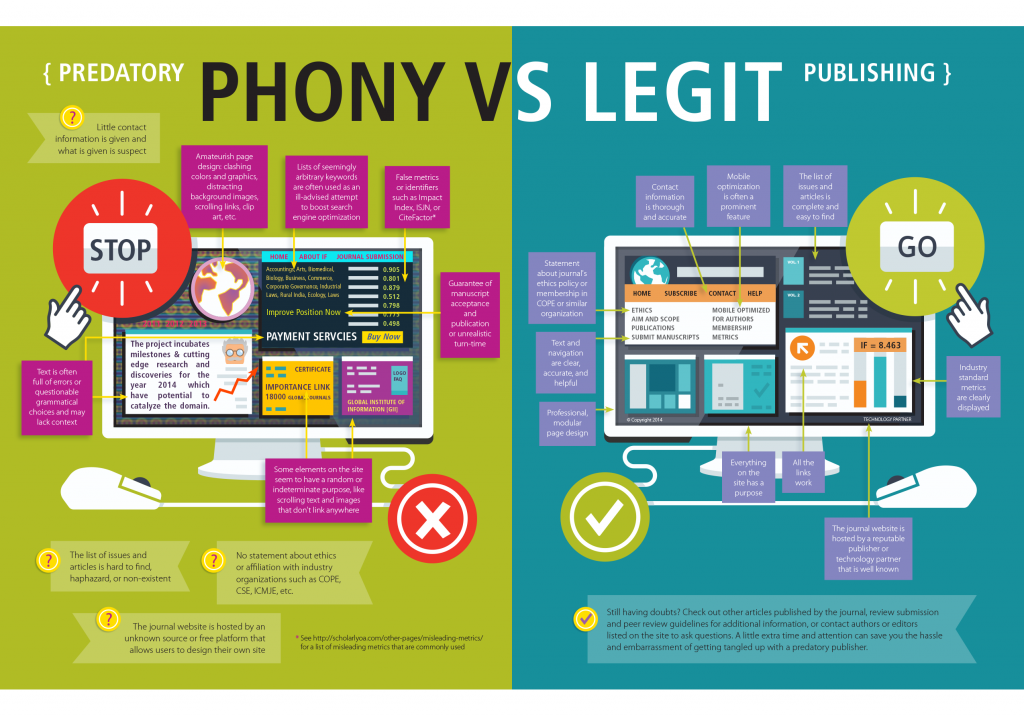As a researcher or scholar under pressure to publish, you may accept solicitations to submit articles for publication even if you are not familiar with the journal or publisher. Some of these offers are legitimate but others turn out to be scams perpetrated by predatory publishers. It is wise to take a few basic steps to learn more about a new or unfamiliar scholarly journal. If you have questions, or want to discuss scholarly publishing, contact Mona Ramonetti, Head of the Center for Scholarly Communication: mona.ramonetti@stonybrook.edu | 631.632.1740.

Great research deserves a great publisher.
Guidelines for Evaluating Journals and Publishers
About the Journal
- Discover peer-reviewed journals using library search tools
- Examine the aims and scope: are they appropriate for your research?
- Review past issues: does the content look topical and credible? Are the authors known to you?
- Investigate it’s history of article retractions using Retraction Watch
- If open access, is it registered in the Directory of Open Access Journals (DOAJ) The DOAJ vets journals before listing them.
- Does the website provide complete contact information: email, street address, working phone number?
- Does it have a valid online ISSN?
- Journals are disseminated via research databases (academic abstracting and indexing services) such as JSTOR, PubMed, EBSCOhost, ProQuest (even Google Scholar). A journal website should say where it is indexed.
- Is it indexed in the places it says it is?
- Has it been assigned ranking(s)? E.g.
- SCImago Journal Rank (SJR) Indicator
- Journal Citation Reports (JCR)
- Journal Metrics by Scopus
- Are its policies on peer review, open access, copyright publicly available?
- If it charges publication fees, are they clearly stated and explained?
- What are the copyright policies? Will you be able to preserve copyright over your work? If you are required to meet a public access mandate to share your research, are the copyright policies compatible? In many open access journals, authors retain full copyright to their work and give the journal a “non-exclusive” right to publish the work.

About the Publisher
- Where is it located? Use SHERPA/RoMEO to discover details about publishers, including country of origin.
- Website
- Stable web page
- Basic contact info: publisher, contact details, editorial team, editorial/advisory board
- Description: scope and focus, publication frequency, author guidelines
- Fee policy clearly stated
- Free of grammatical errors and typos
- Is there a digital preservation policy in place?
- If open access, is it registered with the OASPA (Open Access Scholarly Publishers Association)? Many of the largest open access publishers are members of the OASPA, though there are legitimate open access publishers that do not belong.
- Publisher’s permissions/ sharing policy available on website? Via SHERPA/RoMEO?
- Does it meet the Criteria for Evaluating Scholarly Publishers (PDF)?
- If open access, does it meet the Criteria for Evaluating Scholarly Open Access Publishers (PDF)?
More Information
Contact your liaison librarian or Mona Ramonetti, Head of Scholarly Communication. See a detailed infographic on predatory publishing.
Sources


